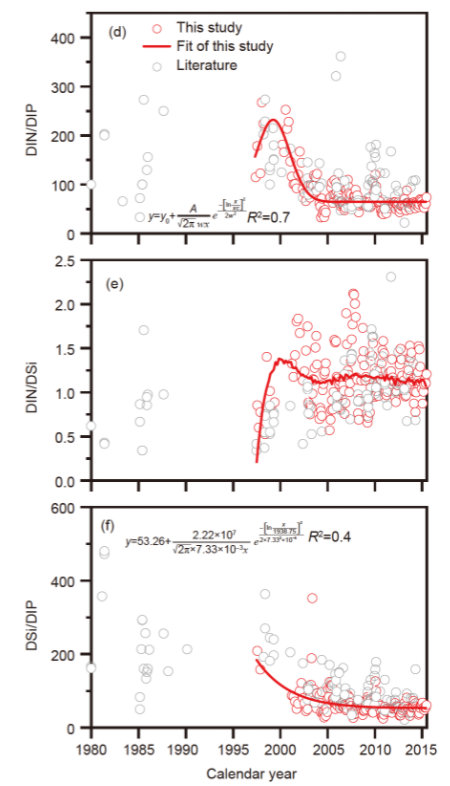从水源地青藏高原到海洋:与土地利用变化和气候变异相关的长江营养盐状况
华东师范大学张经院士带领的科学团队基于20世纪80年代初以来的多次流域考察和近口门处的长时间定点观测数据,研究了世界十大水系之一长江的营养盐(N、P和Si)变化情况,研究区域覆盖了整个流域约80%的面积(即1.8×106km2)和约70%的河道,包括长江干流以及15条主要支流。该项成果发表在《中国科学:地球科学》英文版。
文章研究发现,流出青藏高原以后,长江水体中主要来源于人文活动的营养物质(如氮和磷)的浓度显著增加,并且在一些流经人口众多和农业面积广泛的地区的主要支流中还观察到了氮磷比例的变化,这种影响可以一直到长江下游,直至河口都可以被发现(图1)。

图1 长江干流营养盐浓度的剖面. 垂直箭头表示主要支流的汇合处,水平箭头表示三峡水库的位置
与之前的研究结果不同,该文提供的证据证明三峡大坝和水库对所谓的“营养盐截留”的影响相当有限。2003~2016年观测的结果显示,水库上游和大坝下游的水体中的营养盐之间并没有系统性差别,即使是溶解态硅酸盐也是如此。
自上世纪80年代以来,位于近河口区的长时间序列观测数据表明,河流中溶解态的无机氮和磷的浓度呈持续增长模式(图2)。无机氮在上世纪80年代初就开始升高,而磷酸盐在90年代中后期也大幅增加,而且增长率高于氮。这使得长江与其他世界十大河流系统相比,在人为营养物质负荷和组成比例方面具有独特的特点。

图2 利用长江河口的时间序列数据构建的营养趋势
此外,该研究还揭示了在调节长江入海物质通量方面,受潮汐影响的三角洲地区具有重要的作用,但是在以前的工作中这种作用往往被忽视了。在三角洲地区,营养物质的再活化对溶解无机氮和硅酸盐的浓度的增长贡献了5%~10%,而对磷酸盐的贡献高达20%,如此大的贡献并不是农业活动的影响,而是与沿海地区的城市化活动密切相关。
与其他河流相比,长江流域仍处于营养物质的积累阶段,即使目前正在减少农业化肥的施用,流域中“留存”的营养物质仍可以维持河流中氮磷在相对较高的浓度(图3)。因此,在制定管理战略时需要考虑这些“留存”的资源的潜在影响。

图3 长江流域营养物质估算汇总(仅考虑了主要途径)
基于该研究现有的观测数据和分析结果,可以得出如下结论:从流域尺度上讲,长江中营养盐的持续增加主要是受人类活动影响的调节,气候变化的影响相当有限。
来源:https://mp.weixin.qq.com/s/xlHEOgqQGw-ayF3FTDUAzg
原文:
From the water sources of the Tibetan Plateau to the ocean: State of nutrients in the Changjiang linked to land use changes and climate variability
从水源地青藏高原到海洋:与土地利用变化和气候变异相关的长江营养盐状况
作者:Jing Zhang, Guosen Zhang, Yanan Du, Anyu Zhang, Yan Chang, Yingchun Zhou, Zhuoyi Zhu, Ying Wu, Zaifeng Zhang & Sumei Liu
期刊:Science China Earth Sciences
Abstract
Anthropogenic activity is an important driver of changes in the chemistry of nutrients (N, P, and Si) over watersheds at the sub-continental scale (e.g., 106 km2) and can markedly modify their seaward fluxes to the global ocean. In the present study, we reviewed the current status of nutrient chemistry in Changjiang (Yangtze River) based on data collected through 11 expeditions along a river course spanning 4,500 km and 15–20 major tributaries during 1997–2016 as well as monthly monitoring at the river mouth since 1980. The data were analyzed together with published results in the literature to synthesize the recent developments and current state of nutrients in the Changjiang. Previously published results from the Qinghai-Tibetan Plateau head waters were included to realize the systematics of nutrients for the whole drainage basin. Here, we showed that tributaries of the upper reaches of watersheds collectively determine the regime with high concentration and skewed species ratio of nutrients in the Changjiang mainstream, producing profound effects over a water course of 2,000–2,500 km further downstream and until the river mouth. Moreover, using data across the Three Gorges Reservoir (TGR) during 2003–2016, we evaluated the trapping and/or amplifying effects of the Three Gorges Dam (TGD) on nutrient chemistry. Tide-influenced river delta contributed an additional 20% dissolved inorganic phosphorus and 5–10% dissolved inorganic nitrogen and dissolved silicates to the seaward flux, dramatically affecting the stoichiometry of nutrients at the river mouth. Next, based on compiled data on supply and export, legacy nutrients were evaluated. Both nitrogen and phosphorus are in the accumulation phase over the watersheds, and the legacy nutrient fluxes are much higher than the annual riverine seaward fluxes. Finally, we demonstrated that the seaward fluxes of anthropogenic nutrients from the Changjiang exceed those from other top 10 largest rivers on this planet, which can be attributed to land use changes in the China over the last three to four decades.
摘要:人类活动是次大陆尺度(例如100万平方公里)流域中营养盐(N、P和Si)化学组分变化的一个重要驱动因素,并可显著改变其入海通量。本文研究了长江营养盐的现状,数据来自1997至2016年间11次流域考察,涵盖了约4500公里的干流和15至20条主要支流,以及1980年以来在河口的月度观测数据。结合已发表的文献结果,本文综合分析了长江营养盐的变化和现状;为实现对整个流域营养盐的系统性研究,将青藏高原水系源头的研究成果也包括在内。研究表明,流域上游的支流共同决定了长江干流中营养盐的高浓度和比例失衡,并对下游2000-2500公里直至河口产生显著影响。此外,利用2003-2016年三峡水库的数据,评估了三峡大坝对营养盐的截留和/或放大效应。受潮汐影响的河流三角洲为入海通量贡献了20%的溶解无机磷和5-10%的溶解无机氮和溶解硅酸盐,极大地影响了河口营养盐的化学计量。然后,根据汇编的营养盐收支数据,对营养盐盈余进行了估算。流域内氮和磷均处于积累阶段,营养盐盈余量远高于入海通量。最后,研究得出长江水体中来源于人类活动的营养盐入海通量超过了地球上其他十大河流,主要受过去三、四十年土地利用变化的影响。
(实习生江薇编译)








